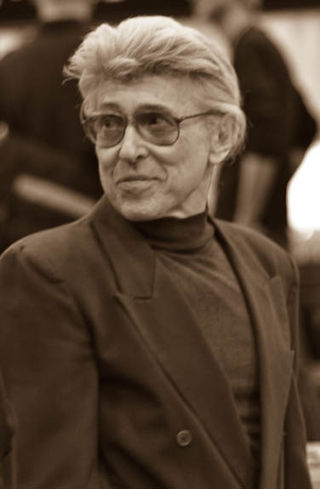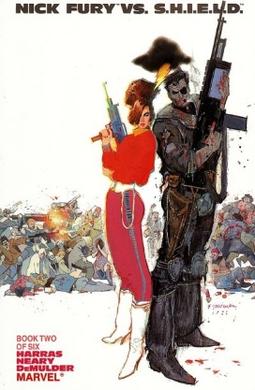
Colonel Nicholas Joseph "Nick" Fury Sr. is a fictional character appearing in American comic books published by Marvel Comics. Created by writer/artist Jack Kirby and writer Stan Lee, he first appeared in Sgt. Fury and his Howling Commandos #1, a World War II combat series that portrayed the cigar-chomping man as leader of an elite U.S. Army Ranger unit.

James F. Steranko is an American graphic artist, comic book writer/artist, comics historian, magician, publisher and film production illustrator.
Strange Tales is a Marvel Comics anthology series. The title was revived in different forms on multiple occasions. Doctor Strange and Nick Fury, Agent of S.H.I.E.L.D. made their debuts in Strange Tales. It was a showcase for the science fiction/suspense stories of artists Jack Kirby and Steve Ditko, and for the groundbreaking work of writer-artist Jim Steranko. Two previous, unrelated magazines also bore that title.

Sgt. Fury and his Howling Commandos is a comic book series created by Jack Kirby and Stan Lee and published by Marvel Comics from 1963 to 1981. The main character, Sgt. Nick Fury, later became the leader of Marvel's super-spy agency, S.H.I.E.L.D. The title also featured the Howling Commandos, a fictional World War II unit that first appeared in Sgt. Fury and his Howling Commandos #1.

The Yellow Claw is a supervillain appearing in American comic books published by Marvel Comics. Created by writer Al Feldstein and artist Joe Maneely, the character first appeared in Yellow Claw #1, published by Atlas Comics, the 1950s predecessor of Marvel.
The Alley Award was an American annual series of comic book fan awards, first presented in 1962 for comics published in 1961. Officially organized under the aegis of the Academy of Comic Book Arts and Sciences, the award shared close ties with the fanzine Alter Ego magazine. The Alley is the first known comic book fan award.

La Contessa Valentina Allegra de la Fontaine is a fictional character appearing in American comic books published by Marvel Comics. Created by writer-artist Jim Steranko, she first appeared in the "Nick Fury, Agent of S.H.I.E.L.D." feature in Strange Tales #159.

This is a list of works by Jim Steranko.

S.H.I.E.L.D. is a fictional espionage, special law enforcement, and counter-terrorism government agency appearing in American comic books published by Marvel Comics. Created by Stan Lee and Jack Kirby, this agency first appeared in Strange Tales #135, and often deals with paranormal activity and superhuman threats to international security.

"Nick's World" is a twelve-page comic book story featured in the second issue of Marvel Knights: Double Shot written by Grant Morrison and drawn by Manuel Gutiérrez. The story concerns a young spy who tries to trick Nick Fury. The story was originally intended to be a part of a much longer series but after the follow-up series proposal was ignored by Marvel, Morrison incorporated much of the psychedelic super-spy material into their Vertigo title The Filth.

Nick Fury, Agent of S.H.I.E.L.D. is the title of several American comic book series published by Marvel Comics focusing on the various adventures of the character Nick Fury while working for the fictional organization S.H.I.E.L.D.

Nick Fury vs. S.H.I.E.L.D. is a six-issue comic book miniseries published by Marvel Comics in 1988. It was written by Bob Harras and drawn by Paul Neary. Each issue is 48 pages long and they are referred to as books. The series was the first time in almost twenty years that Nick Fury and S.H.I.E.L.D. was the main focus and the series sold exceptionally well, prompting Marvel to produce an ongoing series of Nick Fury, Agent of S.H.I.E.L.D. in 1989 that lasted 47 issues.

Fury of S.H.I.E.L.D. is a comic book miniseries written by Howard Chaykin and drawn by Corky C. Lehmkuhl. Published by Marvel Comics in 1995.

Fury: My War Gone By, also known as Fury MAX or Fury MAX: Cold Warrior is a 2012-2013 thirteen issue comic book limited series written by Garth Ennis and published by Marvel Comics. The series follow the character of Nick Fury during his military career under the course of the 20th century after the Second World War, when Fury participated in most of the United States' Cold War initiatives around the globe. Like most of Ennis's previous works on characters that are mainly figures in the world of superheroes so does the series do away with those elements, it instead fixate on the real life dealings of soldiers and spies in historical situations. It is a sequel to the 2001 series Fury and the 2006 series Fury: Peacemaker, both also written by Garth Ennis. The comic was drawn by Goran Parlov who had previously worked with Ennis on his Punisher series. The series garnered decent sales and critical acclaim.

Battle Scars is a six-issue comic book miniseries published by Marvel Comics in 2011 and 2012. The series was created to introduce Nick Fury Jr, the black son of the original Nick Fury to correspond with the version played in the films by Samuel L. Jackson. The series also introduced the character of Phil Coulson from the Marvel Cinematic Universe into the comics.

S.H.I.E.L.D. is a comic book series published by Marvel Comics, premiering with a first issue cover dated 2014. It was written by Mark Waid. The series was loosely based on the TV series Agents of S.H.I.E.L.D. and was used by Marvel Comics to introduce many characters from the show into the world of the comics. After its cancellation it was followed by the series Agents of S.H.I.E.L.D. The series also had a spin-off named Howling Commandos of S.H.I.E.L.D. which picked up after issue 9.

Marvel's The Avengers Prelude: Fury's Big Week, or simply Fury's Big Week, is a limited series comic book published by Marvel Comics as an official tie-in comic to the Marvel Cinematic Universe (MCU), specifically the 2012 film Marvel's The Avengers. The comic was written by Eric Pearson from stories by himself and Chris Yost, with art by various pencillers. Fury's Big Week follows Nick Fury and several agents of S.H.I.E.L.D. as they deal with the various events of the MCU films leading up to The Avengers.

Nick Fury is a 2017 ongoing comic book series published by Marvel Comics. The series is written by James Dale Robinson and primarily drawn by ACO. It is the first series to feature Nick Fury Jr. as its main character.
Secret Warriors is a 2009 comic book ongoing series published by Marvel Comics, the series focuses mainly on Nick Fury and his secret teams, which the title is referencing to as well as members of other hidden groups, such as the ones from Hydra. The series was written by Brian Michael Bendis and Jonathan Hickman, with art by Stefano Caselli. The series ran for 28 issues and ended in 2011.

















